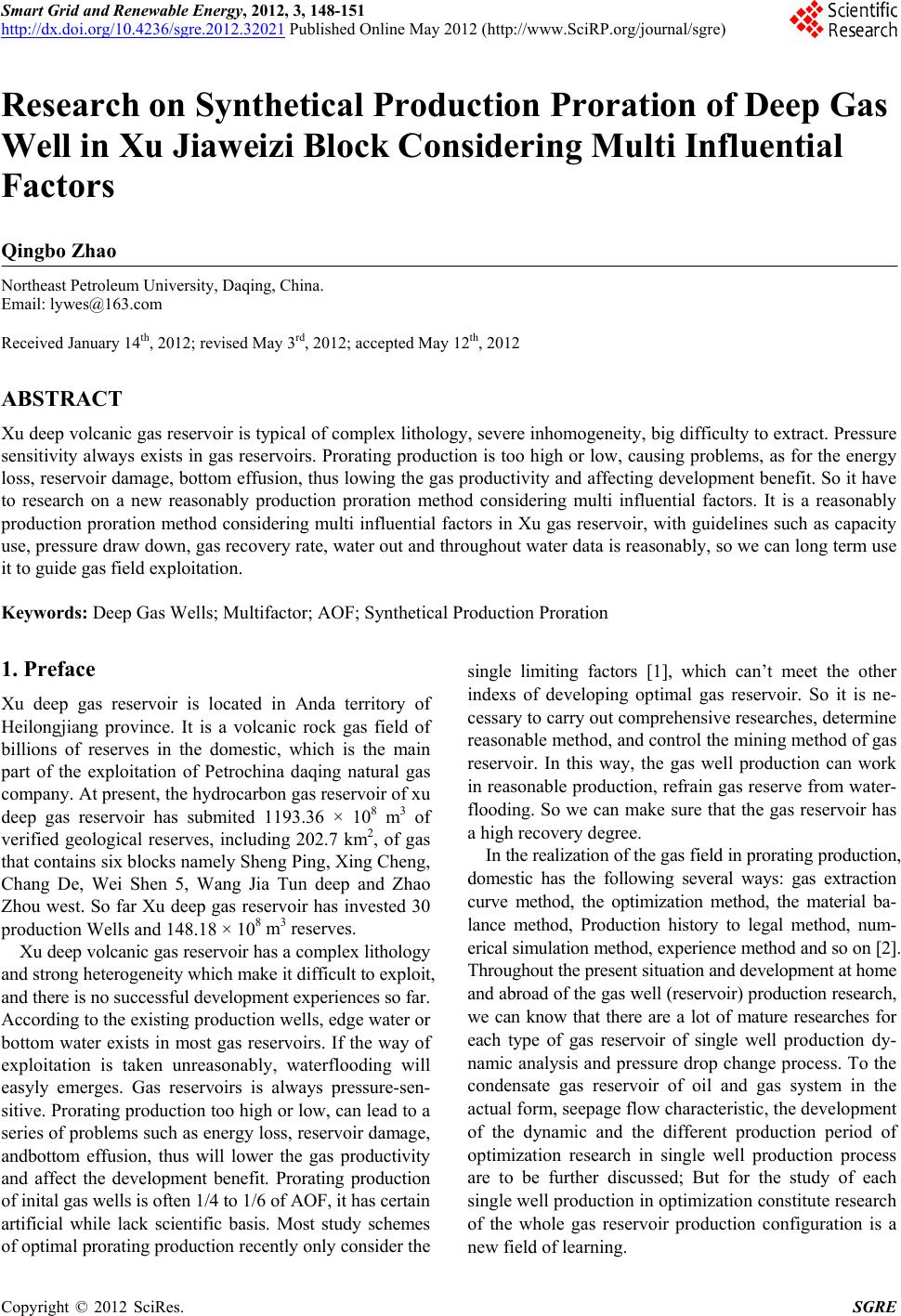
Smart Grid and Renewable Energy, 2012, 3, 148-151
http://dx.doi.org/10.4236/sgre.2012.32021 Published Online May 2012 (http://www.SciRP.org/journal/sgre) 1
Research on Synthetical Production Proration of Deep Gas
Well in Xu Jiaweizi Block Considering Multi Influential
Factors
Qingbo Zhao
Northeast Petroleum University, Daqing, China.
Email: lywe s@163.com
Received January 14th, 2012; revised May 3rd, 2012; accepted May 12th, 2012
ABSTRACT
Xu deep volcanic gas reservoir is typical of complex lithology, severe inhomogeneity, big difficulty to extract. Pressure
sensitivity always exists in gas reservoirs. Prorating productio n is too high or low, causing problems, as for the en ergy
loss, reservoir damage, bottom effusion, thus lowing the gas productivity and affecting development benefit. So it have
to research on a new reasonably production proration method considering multi influential factors. It is a reasonably
production proration method considering multi influential factors in Xu gas reservoir, with guidelines such as capacity
use, pressure draw down, gas recovery rate, water out and throughout water data is reasonably, so we can long term use
it to guide gas field exploitation.
Keywords: Deep Gas Wells; Multifactor; AOF; Synthetical Production Proration
1. Preface
Xu deep gas reservoir is located in Anda territory of
Heilongjiang province. It is a volcanic rock gas field of
billions of reserves in the domestic, which is the main
part of the exploitation of Petrochina daqing natural gas
company. At present, the hydro carbon gas reservoir of xu
deep gas reservoir has submited 1193.36 × 108 m
3 of
verified geological reserves, including 202.7 km2, of gas
that contains six blocks namely Sheng Ping, Xing Cheng,
Chang De, Wei Shen 5, Wang Jia Tun deep and Zhao
Zhou west. So far Xu deep gas reservoir has invested 30
production Wells and 148 .18 × 108 m3 reserves.
Xu deep volcanic gas reservoir has a complex lithology
and strong heterogeneity which make it difficult to exploit,
and there is no successful development experiences so far.
According to the existing production wells, edge water or
bottom water exists in most gas reservoirs. If the way of
exploitation is taken unreasonably, waterflooding will
easyly emerges. Gas reservoirs is always pressure-sen-
sitive. Prorating production too high or low, can lead to a
series of problems such as energy loss, reservoir damage,
andbottom effusion, thus will lower the gas productivity
and affect the development benefit. Prorating production
of inital gas wells is often 1/4 to 1/6 of AOF, it has certain
artificial while lack scientific basis. Most study schemes
of optimal prorating production recently only consider the
single limiting factors [1], which can’t meet the other
indexs of developing optimal gas reservoir. So it is ne-
cessary to carry out comprehensive researches, determine
reasonable method, and control the mining method of gas
reservoir. In this way, the gas well production can work
in reasonable production, refrain gas reserve from water-
flooding. So we can make sure that the gas reservoir has
a high recovery degree.
In the realization of the gas field in prorating production,
domestic has the following several ways: gas extraction
curve method, the optimization method, the material ba-
lance method, Production history to legal method, num-
erical simulation method, experience method and so on [2].
Throughout the present situation and development at home
and abroad of the gas well (reservoir) production research,
we can know that there are a lot of mature researches for
each type of gas reservoir of single well production dy-
namic analysis and pressure drop change process. To the
condensate gas reservoir of oil and gas system in the
actual form, seepage flow characteristic, the development
of the dynamic and the different production period of
optimization research in single well production process
are to be further discussed; But for the study of each
single well production in optimization constitute research
of the whole gas reservoir production configuration is a
new field of learning.
Copyright © 2012 SciRes. SGRE